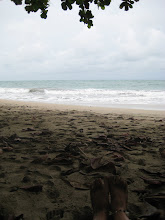Tuesday, September 20, 2011
Gardening I
We started our new beds using a double-dig system. You can read more about it in THIS amazing, amazing book, and here’s a picture.
If that doesn’t make sense (it didn’t to me), think about those number games you had as a kid. There was one hole and all the other number squares were jumbled around and you had to rearrange them in the correct order. Well, double-dig is like taking out the whole bottom row of numbers (or soil in this case) and setting it aside. Then you move the second-to-bottom row into the empty space where the bottom row used to be, and so on until the top row is open. Then you take the soil (bottom row of numbers) you set aside earlier and put it into the top row.
Why? This aerates the soil without disrupting it too much. If you jumble all the soil around, then you’ll get subsoil on the top and topsoil on the bottom. This means that the anaerobic organisms that don’t like air will be freaking out on top and the aerobic organisms that need air will be suffocating on the bottom. No bueno.
After double digging, we covered it with a layer of old, partially disintegrated cardboard that was lying around from last year. We waited a few days. Then we added our Soil Mix (see below) and mulched it. We had some tall grass that had been cut from the orchard so we used that to spread a thin layer over the Soil Mix, and then we watered it. The amount of water you use would depend on your area.
Soil Mix. You have to know what kind of soil you have…ask around. This recipe is for the very clay-ey soil that we have here. Why use a soil mix? Especially in clay soils, mixes provide structure so that the dirt doesn’t become so compact that the roots can’t grow, it holds in moisture, and provides lasting nutrients for the plants. We used part sawdust (it was from a mill that doesn’t treat its lumber with nasty chemicals), part topsoil from the large hole we dug to make a pond, part compost, part sand (a bit less of this), and effective microorganism liquid from the bananas we had let ferment.
If I remember correctly, we didn’t mulch all of our existing, established beds. We put a layer of compost, a layer of mulch (on the ones that were not already packed with plants), and then watered it.
Seriously check out that book if you have an interest in gardening. It teaches you from the get-go beginner level on up to the established, experienced gardener. It talks about when to plant, when to weed, when to move seedlings, etc. It talks about companion planting so you can plant a few plants in the same area that help each other out. A group that work well together is called a guild and the classic example is corn, beans, and squash. You can plant all three seeds in the same hole. We’re giving the corn a head start. The corn provides a stalk for the beans to grow up and the squash provides ground cover to keep nutrients in. And the beans provide the nitrogen that one of the other plants needs. So you end up planting WAY more plants in a smaller area than you were using before. And there’s just a ton of other good info, period. Happy gardening.
Subscribe to:
Post Comments (Atom)


1 comment:
I love this Kate! I'm so excited to get this book and start the learning process. It feels really daunting, so I'm glad it's set up to help you start slow and implement more as you master more. Awesome!
Post a Comment